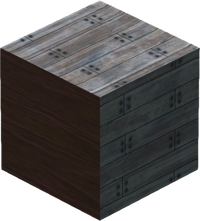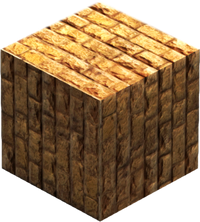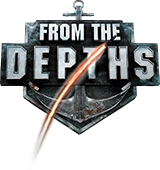Fourgreenfields (talk | contribs) m (→Blocks: HA is 5 times the cost of metal on both stable and devtest (25 mats vs 5 mats)) |
(→Blocks: Overhauled the description of Heavy Armour. Previous version claimed that the difference in cost between Metal and HA is 25 materials, however to my knowledge the costs are currently 5 and 25 materials, respectively. This makes for a cost difference of 20 materials, meaning that the cost of HA is currently 4 times greater than that of metal (5+(5x4)=25).) Tag: Visual edit |
||
| Line 78: | Line 78: | ||
|Eye protection. |
|Eye protection. |
||
| − | Nearly useless as armour, glass slopes nonetheless |
+ | Nearly useless as armour, glass slopes nonetheless remain widely used as a way of preventing [[AI#Detection|visual]] detectors causing drag, and as see-through anti-fragmentation protection for the player character when manually controlling a vehicle from its bridge or cockpit. |
Tip: glass blocks become invisible when looked at through other glass blocks. This allows the player to turn a two-block thick wall of glass into a one-way tinted window. |
Tip: glass blocks become invisible when looked at through other glass blocks. This allows the player to turn a two-block thick wall of glass into a one-way tinted window. |
||
| Line 102: | Line 102: | ||
|25 |
|25 |
||
|Full set |
|Full set |
||
| + | |High-cost, High-density protection. |
||
| − | |Volume-efficient, but cost-, and weight-inefficient armour. |
||
| − | + | While its hitpoints and Armour Class are second to none, this high-tech armour costs four times more than metal, is as dense as lead, and is vulnerable to [[Damage#EMP Damage|EMP jolts]]. |
|
| + | |||
| + | For most purposes, using several layers of metal will provide more protection at a lower cost and weight. |
||
| + | |||
| + | HA is thus best used either in small amounts to protect important parts of a vehicle, or as a backing plate to boost the AC of other, cheaper armour blocks. |
||
|- |
|- |
||
| [[File:Surge Protector.png|200px]] |
| [[File:Surge Protector.png|200px]] |
||
Revision as of 19:03, 22 February 2020
| This article is a stub. You can help From the Depths Wiki by expanding it. |
There are many components in the game. Each component or block belongs to a category.
Categories
Blocks
The core building blocks, beams, slopes and corners.
The "full set" of shapes includes the basic block, 2m, 3m, and 4m beams, 1-4m slopes, diagonal 4m slope, 1-4m left and right square and triangle corners, 1-4m inverted triangle corners, 1-4m wedges, 1-4m poles, and 1-4m front and back wedge slopes.
| Image | Block | Health | Armour | Weight | Cost | Shapes | Notes |
|---|---|---|---|---|---|---|---|

|
Wood | 180 | 3 | 10 | 1 | Full set, and aesthetic versions of the normal block | Paper on its own, but useful combined with other materials
Very cheap, relatively buoyant, and offering some protection against EMP, wood is nonetheless lacking both in hitpoints and armour class, though it can provide useful protection when backed by high-AC materials, or as a spall liner |

|
Stone | 300 | 7 | 40 | 3 | Full set | Damage Sponge.
Far tougher than wood, and fairly cheap, but also heavier, stone is best suited as an ablative outer layer built on top of something with higher Armour Class. |

|
Metal | 350 | 15 | 40 | 5 | Full set + structural and non-structural variations in the "Decorative" section | General-purpose armour.
High hitpoints and armour class makes this block useful both as stand-alone armour and as a reinforcing layer behind stone or wood. The "porthole" decorative block does not obstruct Visual detectors |

|
Light-Weight Alloy | 260 | 13 | 5 | 5 | Full set + structural and non-structural variations in the "Decorative" section | Light-weight armour.
Lightest structural block, and with about 2/3 the toughness of metal, alloy is very useful for aircraft and other weight-sensitive vehicles. Reduced sonar-, and radar-signature, compared to most other materials. |

|
Glass | 60 | 1 | 10 | 1 | Full set, window block aesthetic variant | Eye protection.
Nearly useless as armour, glass slopes nonetheless remain widely used as a way of preventing visual detectors causing drag, and as see-through anti-fragmentation protection for the player character when manually controlling a vehicle from its bridge or cockpit. Tip: glass blocks become invisible when looked at through other glass blocks. This allows the player to turn a two-block thick wall of glass into a one-way tinted window. |

|
Lead | 300 | 4 | 200 | 3 | Full set | Ballast
Incredibly dense, lead is best used as a simple means of changing a vehicle's centre of mass, most commonly as a keel for boats. Tip: For very small or light vehicles, including aircraft, Stone might be a better choice of ballasting material |

|
Heavy Armour | 1000 | 40 | 200 | 25 | Full set | High-cost, High-density protection.
While its hitpoints and Armour Class are second to none, this high-tech armour costs four times more than metal, is as dense as lead, and is vulnerable to EMP jolts. For most purposes, using several layers of metal will provide more protection at a lower cost and weight. HA is thus best used either in small amounts to protect important parts of a vehicle, or as a backing plate to boost the AC of other, cheaper armour blocks. |

|
Surge Protector | 250 | 5 | 10 | 20 | Block | Absorbs EMP damage at 90% resistance. |

|
Rubber | 100 | 3 | 20 | 3 | Full Set | Stealthy shock-absorber.
This block neither deals nor receives collision damage. It also has the lowest radar-, and sonar-signature in-game. |

|
Light block | 50 | 3 | 1 | 20 | Block | Does not collide with other blocks. Cannot be hit by projectiles. Explodes when destroyed. |

|
ERA Armour | 100 | 3 | 40 | 5 | Block, 1m slope | Detonates when below half health or touched by a HEAT stream. Stops HEAT streams, destroys non-CRAM projectiles in front of it and nearby it[citation needed], and reduces explosion damage and radius to 20%. |
Water
Components specific to ships and submarines.
| Image | Block | Health | Armor | Weight (t) | Material | Additional Stats | Notes |
|---|---|---|---|---|---|---|---|

|
Propeller | 300 | 10 | 0.3 | 30 | Force: 150
Power use: 5 |
Needs 8 blocks of clear space in front of it to function at full efficiency. Provides force when in water. |

|
Huge Propeller | 2700 | 10 | 2.7 | 270 | Force: 3000
Power use: 75 |
Needs 8 blocks of clear space in front of it to function at full efficiency. Provides force when in water. |

|
Rudder | 85 | 1 | 0.15 | 10 | Force per mass: 1 | Needs 8 blocks of clear space in front of it to function at full efficiency. Provides turning force when in water. Amount of force increases with vehicle mass. |

|
Air Pump | 85 | 4 | 0.1 | 10 | Buoyancy per volume: 3 | Pumps water from an enclosed or non-flooded space and provides buoyancy. Amount of buoyancy provided is adjustable. |

|
Paddle | 75 | 3 | 0.01 | 3 | Force per velocity: 2.5 | Provides force when moving through water. |

|
Hydrofoil | 85 | 1 | 0.05 | 3 | Force per velocity: 10 | Provides force proportional to the speed and angle at which is is moving through water. |

|
Sail Main Block/Sail Main Block(Square Rig) | 85 | 1 | 0.05 | 15 | Main block of a sail. Sails create force based on both the strength and direction of the wind and the size of the sail. Normal block creates a rounded/triangular sail. Square rig creates a square sail. | |

|
Sail Attachment | 85 | 1 | 0.05 | 1 | Attaches to the main block to expand the sail. | |

|
Sail Winch | 85 | 1 | 0.05 | 1.5 | Attaches to the end of the sail to allow the adjustment of sail size using a controller. | |

|
Weather Vane | 25 | 1 | 0.01 | 1 | Points in the direction of the wind. |
Air
Components specific to planes, hot air balloons and space ships.
Control
All of the components required to control your vehicles, spin blocks and sky fortresses as well as other components such as chairs and fire control computers.
Resource
Resource gathering, processing and storage components.
Engines
Engine components as well as electric engines and generators.
Misc
Various things that allow for repairing, spawning and re-spawning amongst other things.
Simple Weapons
A variety of one-component weapons.
Missiles
Everything you need to make missiles, torpedoes, mines and depths charges.
Decorations
Doors, stairs, lights, etc.
CRAM Cannons
Ballistic projectile weapons.
Advanced Cannons
Laser
Laser and anti-missile projection systems.
AI
AI components used to make autonomous vessels
Collections
Subobject
Subobjects are attached to spin blocks or turrets. Entire subobjects may be saved, and then later loaded in a single step.
Prefabs
Allows loading and saving of large chunks of a vehicle.
